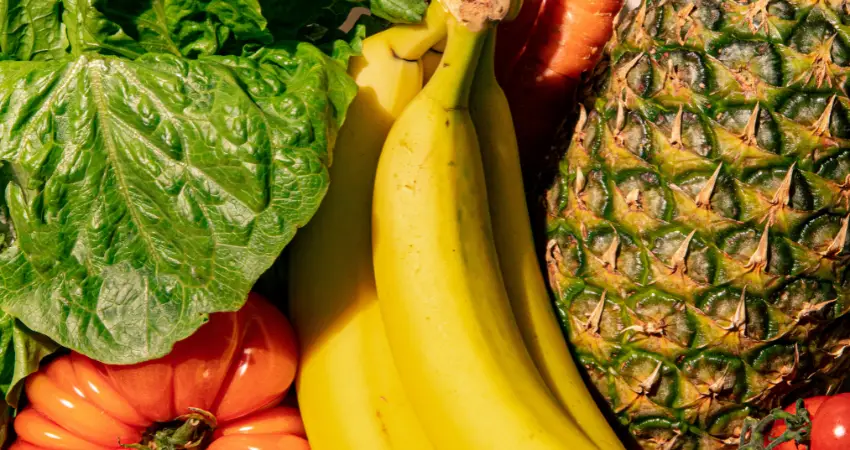Determining if a snack is blood pressure-friendly involves considering several factors, including its calorie content, mineral composition, potassium levels, and whether it is minimally processed.
Here’s a breakdown of how each of these factors contributes to identifying a snack that supports healthy blood pressure levels:
1. Calories: Blood pressure-friendly snacks are generally low in calories. Opting for snacks that are lower in calories helps prevent excessive calorie intake, which can contribute to weight gain and potentially affect blood pressure.
Choosing snacks with controlled calorie counts can support weight management, a crucial aspect of blood pressure control.
2. Minerals: Certain minerals play a vital role in blood pressure regulation.
Two minerals that stand out are potassium and magnesium. Potassium helps balance the effects of sodium, promoting healthy fluid balance and relaxed blood vessels.
Magnesium also contributes to blood vessel relaxation and supports overall cardiovascular health. Snacks rich in these minerals can contribute to better blood pressure management.
3. Potassium: Potassium is a key nutrient for maintaining healthy blood pressure levels.
Foods high in potassium help counteract the effects of sodium by promoting diuresis (increased urine production), which helps regulate fluid balance.
Snacks that are potassium-rich, such as fresh fruits (e.g., bananas, oranges) and vegetables (e.g., spinach, sweet potatoes), can be considered blood pressure-friendly options.
4. Minimally Processed: Processed snacks often contain high levels of sodium, unhealthy fats, and added sugars, which can contribute to elevated blood pressure.
Easy and Tasty Snack Ideas for Optimum Blood Pressure
Choosing minimally processed or whole food snacks is a good strategy for avoiding excessive sodium intake and consuming nutrient-dense options.
Fresh fruits, vegetables, nuts, and seeds are examples of whole foods that make excellent blood pressure-friendly snacks.
5. Sodium Awareness: While sodium is an essential nutrient, excess consumption can lead to increased blood pressure.
Blood pressure-friendly snacks should be low in sodium or should contain sodium in moderation.
Reading nutrition labels and choosing snacks labeled as low-sodium or sodium-free can help you make informed choices.
6. Fiber Content: Fiber-rich snacks, such as whole fruits, vegetables, nuts, seeds, and whole grains, contribute to heart health and can aid in blood pressure management.
Fiber helps regulate digestion, maintain steady blood sugar levels, and support overall cardiovascular health.
7. Healthy Fats: Snacks that contain healthy fats, such as unsaturated fats found in nuts, seeds, avocados, and olive oil, can positively influence blood pressure.
These fats contribute to heart health and help maintain the flexibility and integrity of blood vessels.
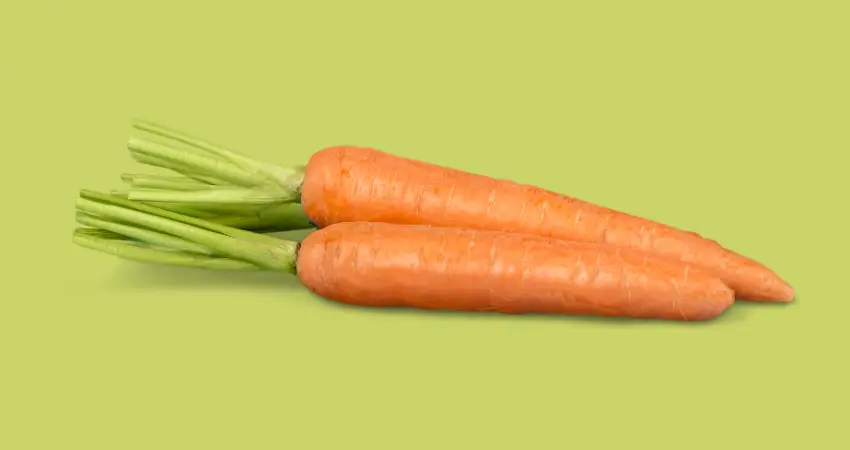
When evaluating whether a snack is blood pressure-friendly, consider its nutritional profile, focusing on factors such as calories, potassium, minerals (especially magnesium), sodium content, and processing level.
Opting for snacks that align with these criteria can contribute to your efforts in maintaining optimal blood pressure levels and overall well-being.
Remember that a balanced diet, regular physical activity, and stress management are also important components of blood pressure control.
Fruits For Optimum Blood Pressure Control
Fruits are a fantastic addition to your diet when aiming for optimum blood pressure control.
They provide a wide range of essential nutrients, including potassium, fiber, antioxidants, and vitamins, all of which contribute to maintaining healthy blood pressure levels.
Here are some fruits that can be particularly beneficial for blood pressure management:
1. Bananas: Bananas are renowned for their high potassium content. Potassium helps balance sodium levels in the body, which is crucial for maintaining proper fluid balance and supporting healthy blood pressure.
2. Oranges: Oranges are not only rich in vitamin C but also provide a good amount of potassium.
The combination of these nutrients, along with their natural sweetness and fiber, makes oranges an excellent choice for blood pressure control.
3. Kiwi: Kiwi is a potassium-rich fruit that also contains a significant amount of vitamin C, vitamin K, and dietary fiber. Its unique blend of nutrients supports cardiovascular health, including blood pressure regulation.
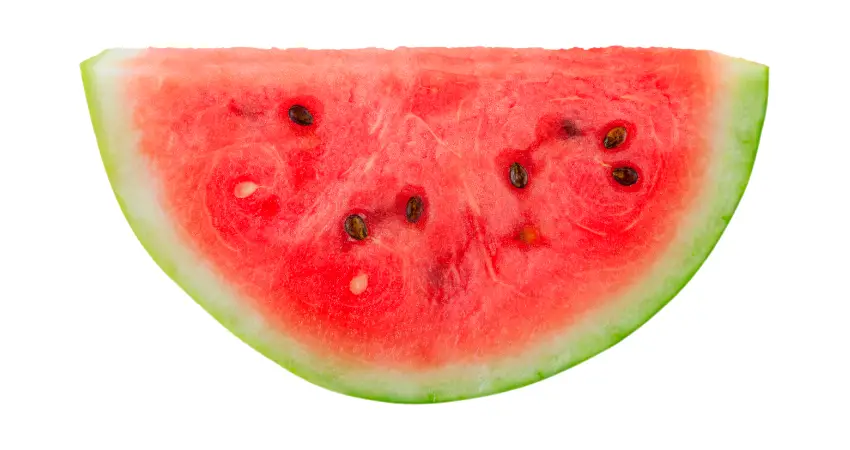
4. Berries (Blueberries, Strawberries, Raspberries): Berries are loaded with antioxidants called flavonoids, which have been linked to improved blood pressure levels.
They also provide fiber, vitamins, and minerals that contribute to overall heart health.
5. Watermelon: Watermelon contains an amino acid called citrulline, which can help relax blood vessels and improve blood flow.
Additionally, it’s hydrating due to its high water content, which is beneficial for blood pressure management.
6. Avocado: Although commonly thought of as a vegetable, avocado is technically a fruit.
Avocado is rich in potassium and heart-healthy monounsaturated fats, both of which can contribute to lower blood pressure.
7. Papaya: Papaya contains an enzyme called papain that may help improve digestion and reduce inflammation.
It’s also a good source of potassium and vitamin C, making it a valuable addition to a blood pressure-friendly diet.
8. Pomegranate: Pomegranate is known for its potent antioxidants, which have been shown to have a positive impact on blood pressure levels. Drinking pomegranate juice or consuming the arils (seeds) can offer these benefits.
9. Apples: Apples are a great source of dietary fiber and antioxidants. Their fiber content can aid in maintaining steady blood sugar levels and supporting heart health.
10. Cantaloupe: Cantaloupe is not only refreshing but also contains potassium, vitamins A and C, and fiber. Its nutrient profile contributes to a healthy heart and proper blood pressure regulation.
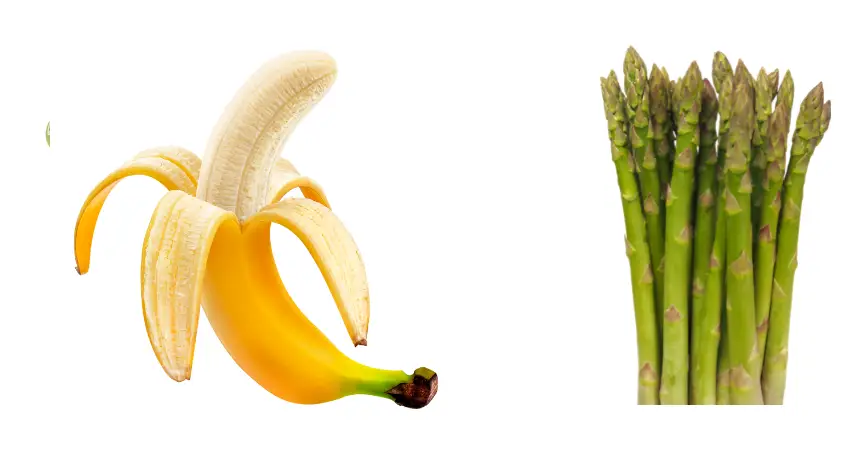
When incorporating fruits into your diet for blood pressure control, aim for a variety of colors and types.
Fresh, whole fruits are preferable to fruit juices, as juices often lack the dietary fiber found in whole fruits.
Including a mix of these blood pressure-friendly fruits in your meals and snacks can contribute to better heart health and overall well-being.
Vegetables for Optimum Blood Pressure
Incorporating a variety of vegetables into your diet is a key strategy for achieving optimum blood pressure control.
Vegetables are rich in essential nutrients, including potassium, fiber, antioxidants, and vitamins, all of which contribute to maintaining healthy blood pressure levels.
Here are some vegetables that can be particularly beneficial for blood pressure management:
1. Leafy Greens (Spinach, Kale, Swiss Chard): Leafy greens are excellent sources of potassium, which helps balance sodium levels and supports blood vessel relaxation.
They are also packed with magnesium and other vitamins that contribute to overall cardiovascular health.
2. Beets: Beets are rich in nitrates, compounds that can help dilate blood vessels and improve blood flow.
Including beets in your diet may have a positive impact on blood pressure regulation.
3. Carrots: Carrots are not only crunchy and delicious but also contain antioxidants like beta-carotene.
These antioxidants contribute to heart health and may help lower blood pressure.
4. Bell Peppers: Bell peppers, whether green, red, or yellow, provide a good amount of potassium and vitamin C.
Vitamin C is associated with improved blood pressure levels and overall cardiovascular health.
5. Tomatoes: Tomatoes contain lycopene, an antioxidant that has been linked to lower blood pressure.
They also provide potassium and other nutrients that support heart health.
6. Sweet Potatoes: Sweet potatoes are rich in both potassium and dietary fiber.
They have a lower glycemic index compared to regular potatoes, which can contribute to steadier blood sugar levels.
7. Broccoli: Broccoli is a versatile vegetable that contains a variety of nutrients, including potassium, fiber, and sulforaphane, a compound with potential cardiovascular benefits.
8. Cucumbers: Cucumbers are hydrating and low in calories, making them a great addition to salads and snacks. They also provide a small amount of potassium and contribute to overall hydration.
9. Zucchini: Zucchini is a mild-tasting vegetable that can be easily incorporated into various dishes. It provides a small amount of potassium and dietary fiber, contributing to a balanced diet.
10. Brussels Sprouts: Brussels sprouts offer a combination of fiber, vitamins, and minerals that support heart health. Their fiber content can help regulate digestion and blood sugar levels.
11. Garlic: Garlic contains allicin, a compound that has been associated with vasodilation (widening of blood vessels) and potential blood pressure-lowering effects.
12. Onions: Onions contain quercetin, an antioxidant that may have beneficial effects on blood pressure and overall cardiovascular health.
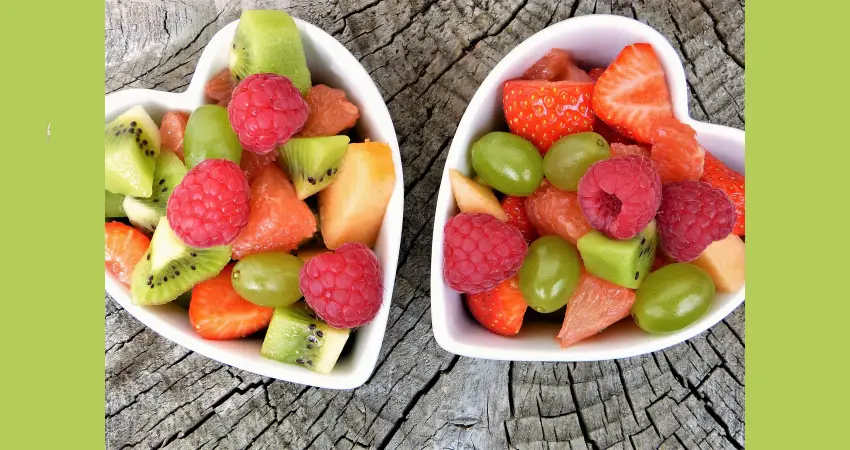
When incorporating vegetables into your diet for blood pressure control, aim to consume a variety of colors and types.
Cooking methods such as steaming, roasting, or sautéing can help retain their nutritional value.
Including a mix of these blood pressure-friendly vegetables in your meals can contribute to better heart health and overall well-being.
Remember that a balanced diet, along with other healthy lifestyle choices, plays a crucial role in achieving and maintaining optimal blood pressure levels.
Other Tips for Optimum Blood Pressure
In addition to incorporating fruits and vegetables, there are several other snack options and tips you can consider for achieving and maintaining optimum blood pressure levels. Here are some more snack tips that align with your goal of blood pressure control:
- Portion Control: Regardless of the snack you choose, pay attention to portion sizes. Overeating, even with healthy snacks, can lead to excessive calorie intake
2. Greek Yogurt: Greek yogurt is a protein-packed snack that provides calcium and probiotics. Choose plain, non-fat or low-fat Greek yogurt and add fresh fruits or a drizzle of honey for natural sweetness.
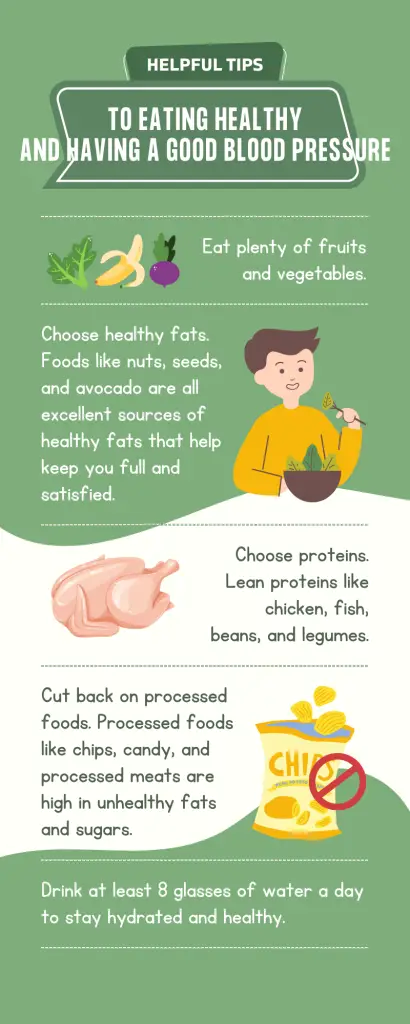
3. Oatmeal: A bowl of oatmeal made with rolled oats is a filling and heart-healthy snack. Oats contain soluble fiber that can help lower cholesterol levels and support blood pressure control.
4. Hummus Variations: Expand your hummus options by trying different variations like roasted red pepper hummus, spinach hummus, or black bean hummus. Pair them with vegetable sticks or whole-grain pita for a nutrient-rich snack.
5. Edamame: Edamame (young soybeans) are a protein-rich snack that provides fiber and is low in sodium. You can enjoy them steamed with a sprinkle of sea salt or with a touch of soy sauce.
6. Cottage Cheese: Cottage cheese is a good source of protein and calcium. Mix it with chopped fruits or vegetables for a satisfying and nutrient-packed snack.
7. Nuts and Seeds: In addition to almonds and walnuts, consider including other nuts like pistachios, cashews, and seeds like chia seeds, flaxseeds, and pumpkin seeds. These provide healthy fats, fiber, and essential minerals.
8. Dried Fruits: Opt for dried fruits like apricots, raisins, or dates as a naturally sweet snack. Just be mindful of portion sizes, as dried fruits can be calorie-dense.
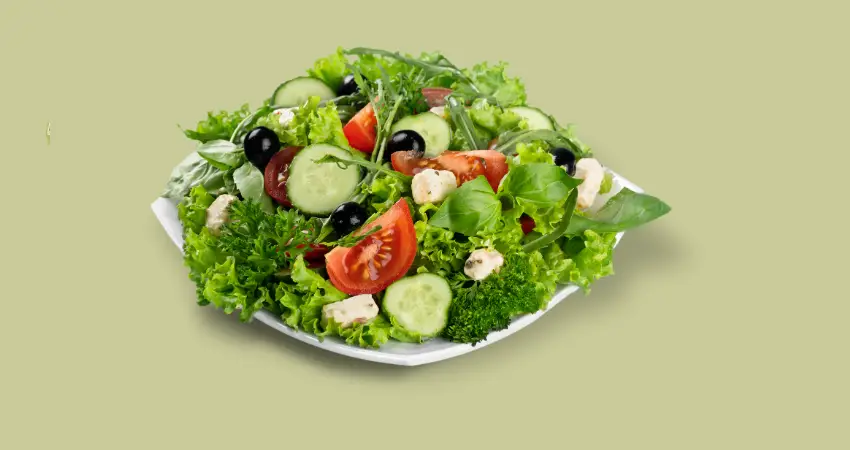
9. Seaweed Snacks: Seaweed snacks are a low-calorie option that can satisfy your craving for something salty. They’re often lightly seasoned and provide minerals like iodine.
10. Dark Chocolate: Dark chocolate with a high cocoa content (70% or more) contains antioxidants called flavonoids that can have a positive impact on blood pressure. Enjoy a small piece as an occasional treat.
11. Trail Mix Makeover: Create a heart-healthy trail mix by combining unsalted nuts, seeds, whole-grain cereal, and a sprinkle of dark chocolate chips or dried fruits. This mix provides a blend of textures and flavors.
12. Hydration with Herbal Tea: Stay hydrated with herbal teas, such as hibiscus tea, which has been associated with potential blood pressure-lowering effects. Opt for caffeine-free options.
Remember that the key to blood pressure control is consistency and balance.
Incorporating a variety of nutrient-rich snacks, along with maintaining a balanced diet and staying active, can contribute to better blood pressure management.
It’s also a good idea to consult with a healthcare professional for personalized guidance and recommendations.
Related Articles
Serrapeptase and blood pressure
Can sinusitis cause blood pressure spikes?
Facts about high blood pressure
Can castor oil lower blood pressure?
150 over 90 blood pressure
Best stethoscope for nurses
My name is Phyllis Robinson MSN, RN. I have been a Registered Nurse for 27 years in the Cardiac Intensive Care Unit. I am passionate about cardiac care and heart disease. I also want this blog to be an educational tool that people can refer to for traditional and alternative treatment. I will blog on heart disorders such as high blood pressure, congestive heart failure, cardiomyopathy, and high cholesterol.
I received my Nursing degree from Baltimore Community College.
I went on to receive my Masters in Nursing from Walden University
I have worked for almost 30 years in Critical Care with a focus on heart health. I am an advocate of preventive healthcare.

